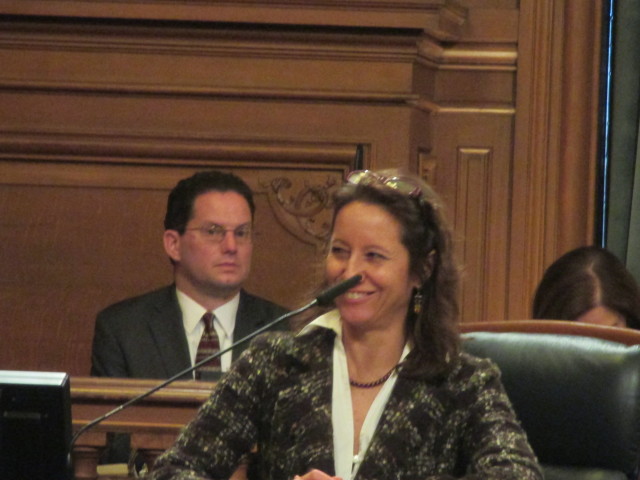There’s no way to have civil consensus with the private utility and still make CleanPowerSF work

By Tim Redmond
FEBRUARY 2, 2015 – It’s odd when a political movement is nervous about a victory, but it happens fairly often in San Francisco. Witness the turnaround by Mayor Ed Lee that might finally allow a modest municipal clean-power effort to move forward.
Lee has consistently sided with Pacific Gas and Electric Co., which hates anything that might give the city a tiny opportunity to get into the business of selling retail electricity.
Even when a supermajority of the Board of Supervisors supported a project called CleanPowerSF, which would allow San Francisco to buy green energy in bulk and resell it to local households, Lee shot it down. His Public Utilities Commission chair, clearly under his direction, made a stunning move to undermine the program, one that has set clean energy in San Francisco back by some two years.
So when the mayor suddenly announced that he would support a new version of CleanPowerSF, advocates were only very cautiously optimistic. PG&E has a long history of dirty tricks; when it comes to public-power issues, nobody trusts the mayor.
And yet, the facts on the ground are the facts on the ground: On Friday, at a joint meeting of LAFCO, the supervisors committee pushing public power, and the SFPUC, everyone was talking about moving CleanPowerSF forward. Francesca Vietor, a PUC member who has always supported the project, called it an “historic day.” So did Supervisors John Avalos and David Campos, who have been fighting for this for years.
And all the while, I was sitting there in the Board chambers wondering: What’s the catch?
Maybe there isn’t one. Maybe the mayor has really, truly, seen the light and wants to make this work. Maybe it’s an election year and now that he has Ron Conway, he doesn’t need PG&E any more. But the problem with having a mayor who bows to corporate interests the way Lee does it that it taints even the good things he’s doing.
But let’s assume for a moment that all is genuine. What, exactly, turned the mayor around?
A couple of possibilities.
One, the concept of the program – a greener alternative to PG&E – is clearly popular. And Board President London Breed, who has always supported CleanPowerSF, told me that she was preparing to put a measure on the ballot in 2015 overturning what the mayor’s PUC did and putting the program into action. That would have looked awful for Lee – he would have had to oppose it, and side with PG&E, when pretty much everyone else in town was on board.
Lee also has an appointment to the PUC pending – and there’s no way anyone, no matter how appealing, would have received a majority of the votes on the board unless that person promised to support CleanPowerSF. Again: A potential defeat for the mayor.
Then, of course, all his arguments had been shot down.
When the mayor opposed CleanPowerSF, he cited a contract with Shell (now gone); a lack of local jobs (now proven wrong); cost problems (wrong), and on and on. The facts were clear: The project would meet every one of the mayor’s concerns. His response was to shoot it down – not to work for a better version. The PUC pretty much stopped work on CleanPowerSF. The person hired to run the project left.
Interestingly, when the mayor decided he didn’t like the plan the supes put forth, he just told the PUC to abandon it. The agency stopped working on CleanPowerSF. The person who had been hired to run it left.
It was the board, through LAFCO, that hired a consultant, found a new approach, met all the mayor’s issues, and kept the thing alive. Now the mayor is finally signing on.
One of the big issues at the hearing was timing. The mayor and the PUC are talking about a fairly slow process, culminating in a rollout sometime next spring. None of the LAFCO member think that’s fast enough.
The way the PUC killed the program last year was to refuse to set the rates needed for the project to get up and running. Jason Fried, a LAFCO staffer, pointed out that there’s no reason to delay at all setting the basic rate, since everyone agrees that the basic product should have as much green energy in the mix as possible – at the same rate PG&E charges.
In other words, the city gives you a better product for the same price.
So we already know what the maximum (“not to exceed”) rate will be. Set it and move on.
The bigger long-term issue is how aggressively the city will move to develop its own renewable energy projects – and to help customers install clean-energy systems on their homes and businesses.
“Such projects are known as ‘Behind-the-Meter’ installations because they are placed inside and on the roof tops of buildings behind PG&E’s profit-making electrical transmission and distribution system,” a press statement from a group of environmental and public-power advocates noted. “Behind-the-Meter installations save communities and ratepayers on transmission costs, and create more jobs than large generation sources in distant locations, such as desert based solar arrays.”
In the end, for many activists the goal of CleanPowerSF has always been to replace PG&E as the supplier of electricity in the city – and to get San Francisco actively involved in the business of power sales.
That’s also the greatest fear of PG&E – and for the mayor to make the program work, he’s going to have to defy the company he used to praise. We’ll see if he’s up to that.




